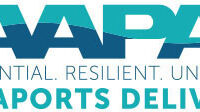Topping the Power Trip

Industries everywhere are decarbonizing. Seaports are no exception; they are driving decarbonization initiatives of every shape and size.
Ports are transitioning to cleaner fuels for cranes, equipment, fleets and general port operations. Some even block access for trucks that pollute. Some are building new energy bunkering and fueling options for vessels and vehicles. Established energy ports and neophytes may now be handling new, cleaner fuels as cargo. Select gateways may be handling solar, wind or other renewable energy plant development components. A few ports are incubating clean energy companies or helping not-so-clean companies mitigate or supporting supply chain partners that invest in clean energy. And some ports are even building their own new energy infrastructure.
It’s Not Good-Bye for Fossil Fuels
Of course, fossil fuels haven’t gone away. They are still used by many port operations but that is changing fast. In the meantime, efforts to reduce idling and push cargo to modes with lower emissions proliferate. And while the emergence of greener energy is inevitable, the thing that won’t change any time soon, according to Sean Strawbridge, CEO of the Port of Corpus Christi, is that ports will continue to handle large volumes of oil and gas as cargo.
Strawbridge said, “Companies cannot function without fossil fuels. Crude oil is…consumed in the manufacture of things like medicines and cosmetics, apparel and footwear. I don’t think Main Street America fully realizes the necessity of hydrocarbons in their daily lives.” In Corpus Christi, energy-related businesses make up approximately 80% of port business.

Novel e-Truck Charging Pilot
The American Association of Port Authorities, ever on the look-out for tech solutions that enhance efficiency of the green chain, honored the Port of Long Beach with a 2020 facilities engineering award for its innovative high-power e-truck charging solution. Developed in partnership with Cavotec and International Transportation Service, the smart e-truck charging pilot project enables rapid and efficient charging of battery-powered heavy-duty terminal tractors. Substantial operational, safety and environmental benefits are in the offing.
The project includes safe, hands-free operation, easy connection and maintenance. It installed fixed 150 kW charging apparatus in the container yard which extends and connects to a receptacle retrofitted on each e-truck. There are 650 conventionally powered terminal tractors currently in use at POLB and tens of thousands around the world. The potential is tremendous.
Cavotec has been a partner with the port for a number of years, developing solutions to “help achieve our electrification goals, including shore power equipment and charging infrastructure for cargo handling equipment,” said Heather Tomley, managing director, planning and environmental affairs for the port. Advancing technology to support clean air in and around the ports is a top port goal.
Trail Blazing Solar

Every day at Port Everglades about 12.5 million gallons of energy cargo is offloaded. While those cargoes are largely hydrocarbon-based, the port’s operational energy is not.
The port is retrofitting diesel service trucks, forklifts and boat engines with energy-efficient clean technology and maintaining a fleet of hybrid/electric pool vehicles. It has introduced wind- and solar-powered terminal lighting. In its latest pursuit, it is slashing energy consumption at its new $120 million 1,818-space cruise garage.
Port garages use energy for lighting, signage, elevators, air-conditioning, payment, motorized walkways, maintenance and other systems. Jonathan Daniels, Port Everglades’ chief executive and port director described the project that has caught the attention of cruise ports everywhere: “On the roof of our new Heron Parking Garage…We installed 360 photovoltaic panels to create a solar-energy-producing system capable of generating 136 kilowatts of electricity, which is used to power the building as well as acquire energy credits with Florida Power & Light’s net-metering program.”
Daniels said the port continually explores these types of investments with a view to compounding benefits: “Port Everglades consistently integrates the environmental, social and economic dimensions of sustainability into our core business strategy. We are…putting the port on the environmental map by giving our attention to a diverse set of initiatives.”
Nation’s First Unit Ethanol Train
Florida doesn’t refine. Fuel shipments are vital. Port Tampa Bay has long been a leading energy gateway and currently handles more than 40% of Florida’s petroleum products. The port is home to a half dozen petroleum product receiving and storage facilities, various pipeline connections, and an innovative central manifold at its expanded petroleum complex that creates economies and facilitates inventory transfer/sharing.
The port entered the renewable biofuel business early on. Almost a decade ago, Tampa Gateway Rail was developed under an innovative public-private partnership between Port Tampa Bay, Kinder Morgan Energy Partners LP and CSX Corp. It created the nation’s first ethanol unit-train-to-pipeline distribution system, plus Florida’s first on-dock unit train capability. Almost $11 million was invested by Port Tampa Bay and CSX, while Kinder Morgan expanded the ethanol terminal’s receiving and distribution capabilities.
Ethanol is an additive for many products, especially gasoline, where its role is to oxygenate the fuel and reduce air pollution.
While the port expects to continue receiving vast volumes of petroleum and related products for the foreseeable future, Wade Elliott, vice president business development of Port Tampa Bay, said that the emerging story is that new energy cargo is now making its mark at the port. “Solar panels and related products, including racking and batteries, have been a significant generator of containerized cargo, and more recently also breakbulk cargo, moving via Port Tampa Bay,” said Elliott.
Making the Energy Transition
At the Port of Corpus Christi, there is a quartet of port MOUs supporting energy transition on the table. The first is with the U.S. Department of Energy’s National Renewable Energy Laboratory, or NREL, and aims to advance collaboration between the port, tenants and NREL by identifying scalable energy transition and decarbonization projects that require analysis, modeling, testing and validation, and pursuing funding opportunities.
As the leading export gateway for United States-produced hydrocarbons, “we see an elegant symmetry in the prospect of becoming the nation’s premier hub for carbon management,” said Jeffrey Pollack, chief strategy and sustainability officer for the Port of Corpus Christi.
The second MOU is with Howard Midstream Energy Partners, LLC to convert Howard’s Javelina refinery services facility into the region’s first carbon-neutral hydrogen production facility. The facility has pipeline connectivity to all six local refineries. Javelina controls 60-million-cubic-feet per day of hydrogen production (hydrogen entrained in waste gas and hydrogen produced through a steam-methane-reformer process) which is currently sold back to industry and used to remove impurities during the refining process.
“The port…is committed to the global energy transition and atmospheric decarbonization objectives by diversifying the energy products that move through our gateway,” said Strawbridge. The NREL partnership will cultivate opportunities for applied research and analytics to eventually help develop scalable alternative energy sources for export.
The third project aims to develop renewable energy infrastructure on port property to support the production of green hydrogen (and potentially provide renewable power directly to the port and its customers). The port envisions a renewable energy and clean-fuel hub that includes solar facilities, battery storage facilities and the electrolyzer facilities that create green hydrogen.
“This project not only brings a new type of economic activity to our gateway, but it will directly meet the needs of our current customers, many of whom use hydrogen in their production processes,” said Strawbridge. Fourth, the Port of Corpus Christi Authority and Stabilis Solutions Inc. plan to facilitate the use of liquid natural gas, or LNG, as a marine fuel, an important step in the port’s broad commitment to decarbonization and improved air quality.

Wintering on Clean Power
In recent years, the Port of Montréal has significantly reduced greenhouse gas emissions – by 25% since 2007 for its own activities. It has rolled out more than 20 shore-power connection points where wintering vessels or cruise ships plug in dockside, a fleet of fully hybrid service vehicles, an LNG fueling solution, and next-generation low-GHG emitting locomotives.
“The Port of Montréal wants to position itself among the forerunners and strengthen its position as a leader on the St. Lawrence in terms of sustainable development,” said Renée Larouche, communication director with Montréal Port Authority. She added that the port’s new cooperation and development agreement with biofuels expert Greenfield Global will help identify, conceive and implement innovative green energy solutions including green hydrogen, ethanol and methanol.
“Developing low-carbon fuels is the way of the future for the transportation industry…Our trade objectives are integral to our sustainable development objectives, and we firmly believe that this alignment will help boost the competitiveness of the St. Lawrence,” said Martin Imbleau, president and CEO of the port, when he announced the deal with Greenfield Global in June.
Record Wind Cargo

Galveston Wharves is embracing measurable environmental improvements with plans that fully transition the port, within five years, to using electricity providers with sustainable power sources. It is partnering with Texas A&M University at Galveston and with Royal Caribbean International on shore-power studies, potentially providing the area’s first LNG-fuel production and bunkering (supplying ships calling on the ports of Galveston, Houston and Texas City), adding alternative-fuel vehicles to its fleet, and installing electric-vehicle charging stations.
Renewable-fuel industries are important to the port’s bottom line. Galveston has been a major player in onshore wind-energy supply chains almost since inception. Rodger Rees, port director and CEO, said, “The Port of Galveston is a major importer of wind energy components, including tower sections, blades, hubs and nacelles. This year, through September 30, the port has handled more than 2,689 pieces, totaling 159,724 tons. This is a 56% increase over 2020 and a new record for the port.”
Rees said the port has the right combination of skilled labor and rail/roadway infrastructure to handle the outsized components being deployed in the current onshore-wind construction boom. The much-anticipated launch of commercial-scale, offshore wind projects also bodes well for cargo growth.
The U.S. Energy Information Administration reported in March 2021 that advances in wind energy technology have decreased the cost of producing electricity from wind, and incentives in the U.S. and elsewhere have encouraged growth in wind power, to the extent that in 2020 wind turbines produced about 8.4% of total U.S. utility-scale electricity generation.
New Decarbonization Options
Wood Mackenzie analyst Maria Yee explained decarbonization options. In an October 2021 opinion to industry, she said, “Low-carbon fuels will be critical for decarbonizing all sectors, especially in areas where electrification and renewable power are less suited.” Low-carbon fuels include biofuels, hydrogen-based alternative fuels and e-fuels. Yee said a combination of commercial readiness, ease of adoption, lifecycle emissions savings and availability will determine which technologies will ‘win’ in each sector.
In Yee’s opinion, “biofuels are best applied in the transportation sector.”
Seaports will play an important role in the race to bring down supply chain costs for the new energy options. There is very little infrastructure in place yet. Growth opportunities abound.
America’s seaports are already hopping on the clean energy bandwagon, even the traditional oil and gas ports.


First in State Electric and Hybrid Truck Fleet
In a pioneering move, the Port of New Orleans has replaced 70 drayage trucks to date for its local trucking community, reducing particulate matter and nitrous oxide pollution by more than 90% for each. Plus, the port was “the first public agency in the state to have a fleet of electric vehicles and plug-in hybrids,” said Emily Federer, the port’s environmental services manager.
Air emissions are a priority at Port NOLA. “We are working on an overarching clean air program to strategize emission reductions for our own facilities and operations, and ways to assist port tenants and operators to reduce emissions, as well,” said Federer. One effort is a marine highway program to reposition empty containers to barges connecting with Memphis, Baton Rouge and New Orleans. Barging is arguably the cleanest inland transport mode.
Also, in August, the port and CLEANCOR Energy Solutions LLC signed an MOU to collaborate on ways to provide LNG-fueling solutions to ship owners and operators. At the time of the announcement, Brandy D. Christian, president and CEO of the port, said, “LNG paves the way of the future and provides a suitable and sustainable fuel source for the diverse cargo operations on our terminals and in our jurisdiction.”
Improving the Footprint for the Future
Ports are an integral part of the supply chains being called upon by shippers, governments and society to lower carbon footprints or face economic wrath.
They are transitioning to clean technologies and low-carbon fuels with an admirable range of programs and initiatives. They are fashioning best practices from scratch. Even while seaports remain in the business of handling and storing hydrocarbons, and indeed, sometimes because of that, they remain committed to clean energy solutions for operations, and are unearthing clean energy cargo opportunities. It isn’t, at least for now, an all-or-none world.



